INTO THERMAL GENERATION PLANTS (MORE ON TURBINES AND ELECTRICITY GENERATION)
Hello Steemians, special appreciation goes to everyone including the Steemstem community for their voluntary support and comment on how to better serve the community. So today this work is mainly based on bringing us to a simplified understanding of the working of a power plant. In my previous post on generation, transmission, and distribution of electrical energy, we scratched the surface of all three phases of how electric power reaches our homes (including us).
There are various methods through which energy is generated, in-fact most parts of the world do not limit themselves to a particular means of generating electrical energy, as we would examine in subsequent posts, there lots of factors to be considered before siting a power station. But for the scope of this post, we would consider thermal power plants.
What is a Powerplant
A plant can be seen as site whereby manufacturing process takes place, therefore seeing that energy is consumed, we consider the power thermal generating station as a plant. However, before we go into details depicting how the power plant works we must first understand some basic terms which would be used subsequently. A turbine can simply be described as a rotating (mechanical) machine whose rotary ability is caused by fluid flow. I am a student of electrical engineering, however, we were required to take some courses on fluid mechanics, in that course we learned that while speaking about fluids, we speak of anything that can be deformed or whose external structure can be deformed. Then we found out that while a majority may limit fluids to liquid, gases/steam can also be regarded as a fluid. In continuation, turbines convert energy into mechanical energy whenever it rotates, it has a generator attached to it. The action of this generator is found when the magnetic blades of the turbine rotate, as discussed in my previous post on generation distribution and transmission of electricity. We discussed that a when the magnetic blade is varied (rotated) along the conductor, then electricity would be generated. When we consider the nature of the turbine, we would see that the turbine has various areas of application e.g in ships, copters, airplanes, even in your cars. (Do you know that the energy gotten from your rotating wheels is what is used to power your speedometer) lest we deviate, let's go back on the rail. Very Simple, turbines convert previously existing forms of energy to mechanical and hence electrical energy right. And our goal is to get the turbine to move irrespective of the form of energy used in achieving this, In fact you can use your hand to roll the turbine. Therefore as in the case of the steam turbine, the action of steam under high pressure is needed to roll the turbine, professionally speaking, a steam turbine is a machine that converts heat energy into mechanical/rotational energy under high pressure. I love the way Wikipedia defines it here. flow chart designed by me @lawkay using draw.io Having established a good background to the study, we would go on to the intricate details that go on in the power station. Now we need to first understand that majority of the activity that occurs in a power station occurs in a bid to transform one form of energy to another and still ensure optimization of this energy (i.e ensuring that there is no waste energy) The flow chart above shows the energy conversion process that takes place in a steam power station. We will, therefore, be considering each phase one after the other. In the thermal station, the primary source of energy is any material that can be converted into heat energy, e.g coal, natural gas, nuclear materials like plutonium or uranium. Heat energy can be produced by any of those means, however taking Drax power station in England as a case study which produces about 4000MW of electricity which accounts for 7% of the united kingdom power need (For more reading about Drax read (this)[https://www.drax.com/]) the primary power source used by the plant is coal, not forgetting that the goal is to generate heat. Now that we have our coal (or whatever means of fuel) fired up, what is the next thing we need to do? Or rather what exactly are we going to use the heat to do. Remember its an energy conversion process, therefore the heat will be converted into another energy source, however. Before transforming the heat into mechanical energy it must be modified. You know we cant just pass flame heat into a turbine just like that, therefore what we shall now do is to use the heat to boil water. To achieve maximum heat, pure water is always used. If you look closely at first image of the power plant, you will see that most thermal plants are sited close to rivers. This is done to minimize the cost of transportation of water every so often and another reason we will consider soon. Now the water is boiled to a temperature above 2000 degree centigrade, it is boiled inside a boiler. The boiler is an oricle of tubings and it is designed to produce steam at maximum pressure. Remember we said that what drives the turbine is pressurized steam. Having boiled the water at high temperature and pressure, we have a ready steam to power our turbine. In the conversion of heat energy to mechanical energy, the turbine is the main system used. It is carried out in a coaxial expansion chamber (inside the turbine blade) this chamber is divided into three part, The high-pressure chamber is the region in which the steam first enters, the turbine blades attached to this chamber is made up of smaller blades since it would spin faster because of its high pressure. The steam then has to be taken back in order to be reheated before it goes into the Intermediate chambers, after this, the steam is straight away fed into the low-pressure chamber, this chamber is made up of larger blades. From the Low-pressure turbine blade, the steam passes through a condenser and cooling transforms it back to liquid, this liquid is then returned back to the boiler. The action of steam on the turbine is in its high pressure, the high pressure transforms it into rotates the turbine blades and we all know what happens when a turbine blade is rotated. Electricity is generated!!! Below is an image to best explain the process Steam cycle Schematic diagram: Adapted from google uner labelled for re-use We need to note that the steam in the Low-pressure chamber still contains a tremendous amount of energy, in fact, more than half of the energy generated from coal fuel, this energy must be disposed before returning back to the boiler, in some power stations they sell the heat energy to neighboring plants which need such, but you know its not a ready market and its not every time you a manufacturing plant near the power station not to talk of their willingness to buy the heat, there are therefore 2 methods in which this heat energy is disposed Direct cooling: Remember I said we would consider another reason why thermal power plants are sited close to rivers, well we are about to understand this. To directly remove the heat from the low-pressure chamber, water would be taken from a large reservoir, river, sea or water tank and pumped into the condenser, then the water is then circulated back into the source from the condenser. Indirect cooling system (Cooling towers): Here we have the water from the condenser passed into a cooling tower then returning to the condenser. Either you use the wet cooling towers or the fry cooling towers, you will still achieve the same results, however, using the wet cooling towers would increase humidity that would ensure constant rain falls. Power must be generated, however, the process of generating power if not well regulated can turn out to be bad business. When coal is burnt, it emits poisonous gases into the atmosphere like Sulphur, Carbon etc. If this poisonous gas is released into the atmosphere and left unregulated and unchecked, it would corrupt the natural habitat of species inhabiting in those regions and disrupt the eco-system. Also, this poisonous gases can release poisonous gases into the atmosphere which is also bad business, in a world where everyone is going green and write-ups has even come from here concerning going green, there should be no further depletion of the ecosystem. HOW IS THIS HAZARD CURBED As the said burning of coal and releasing it to the atmosphere through a chimney is bad business it can cause smog and acid rain due to carbon and Sulphur emissions. However, it is possible to capture up to 90% of this toxic emissions before they hit the atmosphere. How is this done? So you see that doing this not only reduces the Hazard caused by the production process but leads to the production of another material widely used in the building industry. CONCLUSION References For further understanding of the whole procedures, do well to check this out. Effect and hazard of steam power plant If you write STEM (Science, Technology, Engineering, and Mathematics) related posts, consider joining #steemSTEM on steemit chat or discord here. If you are from Nigeria, you may want to include the #stemng tag in your post. You can visit this blog by @stemng for more details.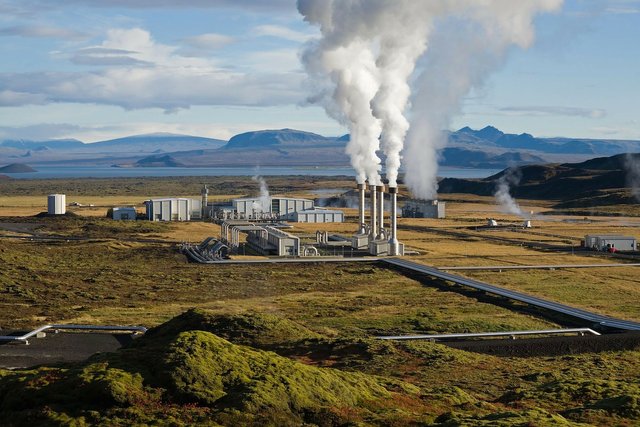
Thermal Power plant under CCO license:
Turbine
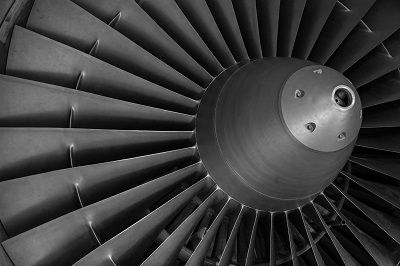
Turbine engine of a motor rotor
adapted from pixabay under CCO commons license:STEAM TURBINE
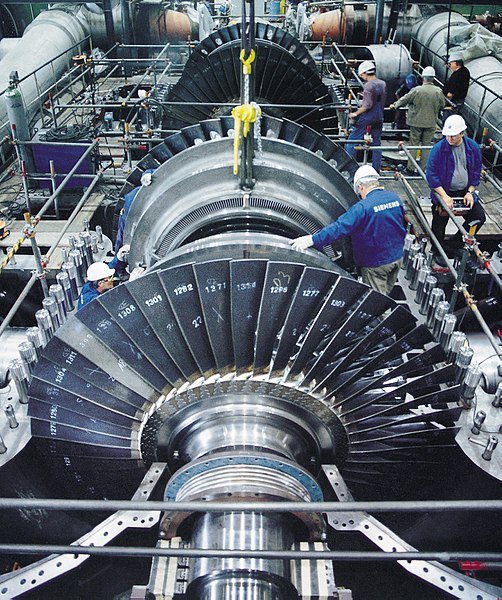
Steam turbine under GNU Free Documentation License
Simple rightINTO THE STEAM POWER STATION

Primary energy source
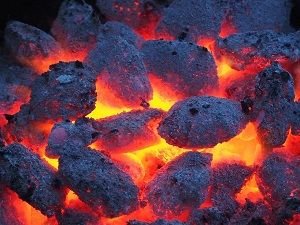
Coal under CCO creative commons license:
The Heat energy produced
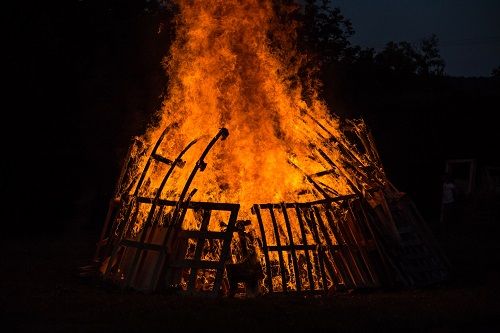
Heat energy: Adapted from pixabay under CCO license: Mechanical/rotational energy (THE TURBINE SYSTEM)
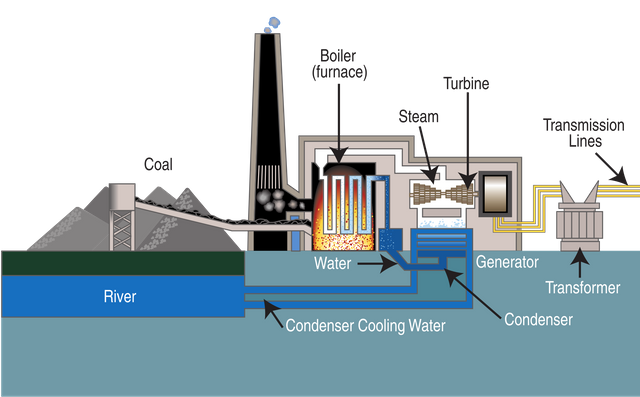
COOLING
HAZARDS OF STEAM POWER STATIONS
The smoke is first allowed to blow through electrostatic precipitators, these electro-static precipitators act as filters and capture the plastic particles (Sulphur and carbon particles), and thus the hazardous gas is filtered and the emission from the chimney is minimized. This attracted particles forms gypsum which is locally known as “plaster sand” you can find out more about gypsum in the reference links.
Gypsum photo by Larry Toole
under labeled for reuse by google:
Steam power plants are extremely important in generating power, in fact, if well exploited, can supply power to millions of homes consistently depending on the power produced. And of course, if the right procedure is followed is safe for use in the certain region.
More about gypsum on Wikipedia
good
Thanks
I must say I am amazed by the shear simplicity of this explicitly written article about Thermal energy. You deserve plenty accolades for this.
He certainly deserves that, no doubt.
He certainly deserves that, no doubt.
Wow!!!
Am glad i was able to demystify this interesting aspect of engineering for all to see!!!
Thanks for the accolades
Give credit to whom credit is due. That's what I'm only doing.
I'm happy to see someone write about the generation of power from steam turbines. I once wrote something on Gas Turbine engines and why Gas Turbine Cars are not available for sales.
Nice Post.
I guess the world is moving faster than predicted... Science is knowledge. Nice one Sir
Of truth Science gives knowledge....
Knowledge empowers
Yeah bro, I'm glad you impact!
What a lovely article, read your previous one on generation, transmission and distribution, dat also was amazing. Just a question, which of the cooling methods is better?
Wow!!!
Its cool to see you read my previous article.
About the cooling system...
Both is good however it depends on the area the plant is located....
Plants locted near rivers or sea can conveniently use the direct cooling method...
But using indirect cooling method( cooling towers) it is mainly used where there is limited supy of water.
Thumbs up man
Nice post here. The turbine part was quite exciting, and i must say I began the real reading from that part to the end. You had me hooked.
In truth, one is bound to learn a lot on here (steemit).
Kudos, Bro.
Thanks Boss!!!
Its really cool to see you are being enlightened...
I myself engage mostly on steemstem because i find it as a knowledge bank where i get enlightened!!!
I was able to read about turbines in a course i did in school about hydro power. This is well refreshing
Cool boss
Thanks
Congratulations @lawkay! You have completed some achievement on Steemit and have been rewarded with new badge(s) :
Click on any badge to view your own Board of Honor on SteemitBoard.
For more information about SteemitBoard, click here
If you no longer want to receive notifications, reply to this comment with the word
STOP